Winton (wikipedia) is a town in Central West Queensland, Australia, 177 kilometres (110 mi) northwest of Longreach. The main industries of the area are sheep and cattle raising. The town was named by postmaster Robert Allen, in 1876 after his place of birth Winton, Dorset. At the 2011 census, Winton had a population of 954.
Qantas
Winton was one of the founding towns of the Australian airline Qantas. The first board meeting was held at the Winton Club on 10 February 1921.
Waltzing Matilda
Winton is intimately involved in the story of the popular Australian folk song, “Waltzing Matilda“, which had its first performance in the North Gregory Hotel in the town. The Waltzing Matilda Centre opened in 1998 and is the first museum dedicated to a song. The song was written by ‘Banjo’ Paterson whilst holidaying at a local property, Dagworth Station. The music for the song was arranged by Christina Macpherson, the sister of the station manager who was visiting at the same time.
In 2012, to remind Australians of the song’s significance, Winton organised the inaugural Waltzing Matilda Day to be held on 6 April, the anniversary of its first performance.
Street Names
The main streets in the town of Winton were named after the stations which were in the direction in which the streets were running. For instance, east and west — Elderslie, Vindex, Cork and Dagworth. Those facing the north were called Oondooroo, Manuka, Sesbania and Werna. Three of these stations Dagworth, Videx and Oondooroo figure in the Waltzing Matilda story.[7]
Dinosaurs
The area surrounding the town has yielded a number of dinosaur fossils, including ‘Elliot’, a sauropod. In 2009, three dinosaur genera, Australovenator, Wintonotitan and Diamantinasaurus, were discovered near the town. Australovenator wintonensis, the type specimen of that genus, is named after the town. The town also lent its name to the Winton Formation.
Royal Theatre
The historic Royal Theatre is one of the few remaining open air picture theatres in Australia and home to the World’s Largest Deckchair which was originally constructed in Victoria by the Freemasons Taskforce in 2002 and donated to Winton and the Royal Theatre by the members of that taskforce in April 2005.
Climate
Winton has a constantly hot climate with summer temperatures ranging from 23 °C to 38 °C while temperatures in the ‘winter’ season range from 9 °C to 25 °C. Temperatures above 30 °C can be experienced throughout the year, and temperatures above 40 °C can be recorded in every month from October to March. Rainfall is concentrated in summer and the yearly average is 414.7 mm (16.3 in). Extremes have ranged from 46.8 °C (116.2 °F) to -1.7 °C (28.9 °F)
Great Artesian Basin
Winton is situated on the Great Artesian Basin. The water supply bursts to the surface at 83C degrees and is then channeled through cooling ponds before being distributed to the town. Sulphur gas gives the water an ‘eggy’ smell.
Arno’s Wall
Arno’s wall is a strange mixture of art and architecture. Cemented contents of the wall include rusted lawnmower parts, boat propellers, vintage typewriters and sewing machines and even a couple of complete motorbikes. A photograph of the wall by Gordon Undy is in the National Library of Australia digital collection
7th August, Thurday
The road to Winton is about 215kms of mainly nothingness. It’s the real outback. The landscape is flat, the odd small tree here and there and just dry grass. The road (Kennedy development road) in many parts is like the bucking bronco again, things fall out of the glove compartment etc. It’s still charming though. We only had 1 car pass us the whole way and thankfully no road trains in this part of the country because the road in places is very narrow. There is no fuel between Hughenden and Winton and only one little place to stop. It’s a roadhouse ‘Stamford’ (population – 2 people and 3 dogs) and what a delightful little place it was. It is run by a husband and wife and they are so friendly and chatty that it took me ages to get out of there. They were telling me that there is a sheep farm close by and they have a problem with dingos taking the lambs. They bought some donkeys to look after the sheep and since then they have lost not one lamb – I have never heard of donkeys being watch dogs before, quite fascinating. Winton is a small town and some people complain about the smell of the water and the facilities, it is an outback town and why some people travel I will never know. I’m not sure if they expect 5 star accomodation and services (stay at home), it’s not what is all about, thankfully it’s only the odd few and generally people are so nice. We booked into a caravan park called the Matilda but I read reviews of the camp site on Wikicamps (the best app. That we have bought) and it didn’t get good reviews. We have found another one which is the Tattersalls Hotel and the van park is across the road from the pub and the publicans again are so friendly and accomodating. We have a huge site on grass (lucky, considering the dry conditions), sheltered from the wind and it is awesome and Hugo is happy that he has grass to roll on and chew. People complain that the water here smells a bit bad but we don’t think it’s that bad. The water comes from 1 ½ kms underground from an artesian well and it’s 83 degrees when it reaches the surface. It goes through a series of cooling ponds before it is distributed to the town and it tastes better than the water you buy in bottles. We will visit the Walzing Matilda museum while we are here. Banjo Patterson wrote “Walzing Matilda” while staying on a station close by. This place is also famous for dinosaur fossils and footprints. We will go and see the Dinosaur stampede prints tomorrow. It is about 110kms from our camp site, so will do that easy in a day. We need to pack water, food etc. as there is nothing around and we have been advised to do that. Ralphie just went to put fuel in Betsy and they gave him 8c off per litre because our tank is so big and 2 free chocolates (Turkish delight, my favourite as you all know). It doesn’t get any better than this. We went across the road to the pub for dinner, the place was humming. It is such an experience being in a place like this, I just can’t explain how good it is. Anyway, we ordered Lamb rack and I think that we got half a lamb each plus about 4 veggies and cauliflower cheese. We were so hanging out for a meal like this. We left Hugo in the van because it’s only across the road and he was happy when we go back. We are leaving at sparrows tomorrow to go and visit our dinosaur relatives. Xxxxxxxxxxxx
- Stamford Roadhouse in the middle of nowhere
- Stamford Roadhouse
- Stamford Roadhouse
- Stamford Roadhouse
- Stamford Roadhouse in the middle of nowhere – population 2, dogs 3
- Stamford Roadhouse
- The menu at the pub in Winton……. the sangas sort of go blocked out 🙁
- The view of the pub from our caravan 🙂
8th August, Friday
We went to see the Dinosaur stampede today. Its 110kms there and then another 110kms back. The road is about 55kms of Gravel and then 55kms of bitumen. The gravel road is in good condition and actually better and quicker than the bitumen. Queensland is not renowned for their good roads. A small section of the road is an emergency landing strip which you find from time to time in the never nevers, it is used mainly for the RFDS and for Care Flight (which is the same as the RFDS. These landing strips are in the Pilbara and the Kimberleys as well in fact in all remote areas. The plains are very dry and in some big sections there is nothing living, not even birds. There is no water and nothing to eat as it’s all spinifex. I copied a little detail of what the Dinosaur stampede is off the net because they would explain it better than I would.
“95 million years ago Lark Quarry was part of a great river plain, with sandy channels, swamps and lakes brimming with freshwater mussels, lungfish and crocodiles. Rainfall was over a metre per year, so the surrounding lowland forest was lush and green..On the day our drama unfolds, some 95 million years ago, herds of small two-legged dinosaurs came to drink at the lake. There were at least 150 dinosaurs of two different kinds – carnivorous coelurosaurs about the size of chickens, and slightly larger plant-eating ornithopods, some of them as large as emus.A huge meat-eating theropod, smaller than a Tyrannosaurus, approached the lake. It slowed, saw the other dinosaurs gathered at the water’s edge and began to stalk, then turned and charged. The stampeding herd of smaller dinosaurs left a chaotic mass of footprints in the mud as they ran to escape.”
It was a very interesting visit and you can’t believe how old those footprints are and the fact that the site was found, excavated and preserved and protected for us all to see. On the way back, closer to town we came across some brolgas and some emus, the only life that we had seen the whole way. It was a long day and a good day. We are about to have a bbq and have an early night.
- Brolgas
- The never, nevers
- Not sure what this is
- Spinifex and the never, nevers
- Dinosuar centre
- Footprint of the big one
- Footprints of the little ones
- The big one and the little ones
- The big one and the little ones
- Footprints
- Footprints of the big one and the little ones
- little ones
- RFDS and Care flight landing strip on the road
- Not sure about the bulldust? 🙂
- Emus
- Emus
9th August, Saturday
We decided not to do much today. There is just one museum that was maybe worth a visit and it’s within walking distance of the caravan park. I told Ralph to go first and someone has to stay with Hugo and also to see if it was worth me going as I am not a museum type person. Ralph came back after nearly 2 hours and told me to go. I am glad I did as I really did enjoy it. It was all the history of the Walzing Matilda song and of the bush and a swagman and all that sort of stuff. Tomorrow we head off for Longreach, so not much more to tell you for today.
- Once a jolly swagman
- Winton
- Only find street stuff like this in the outback
- Winton
- Winton (that’s it)
- One of the 4 hotels in this tiny town – priorities
- Winton
- Tattersalls hotel – we are staying across the road
- display in the main street – in fact there is only one street
- Pelican pond
- The tatts hotel, as it is known – check the dudes on the verandah
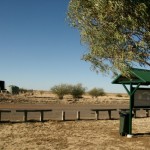
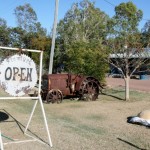
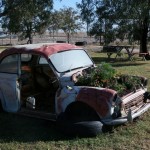
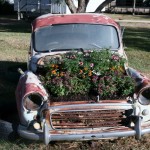
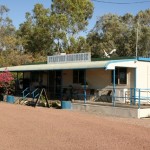

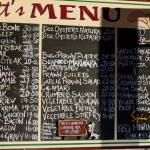
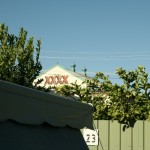
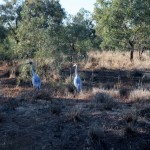
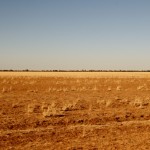
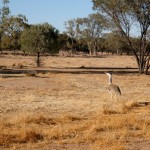
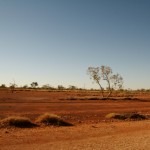

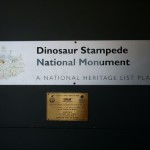
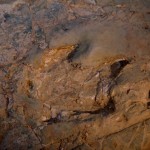

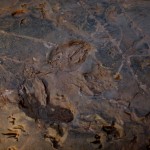


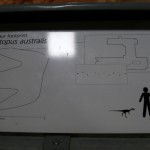

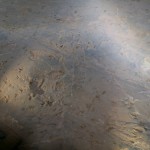
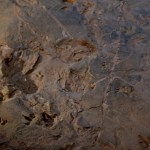


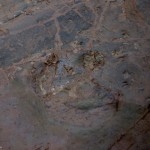



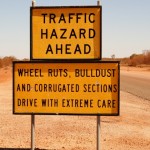
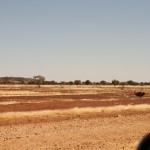
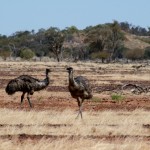


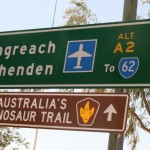
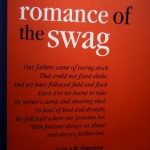

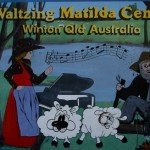


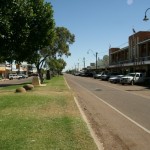
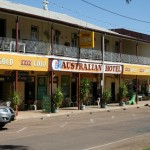
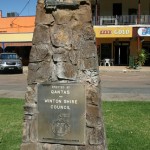

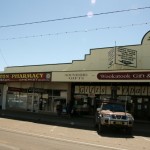
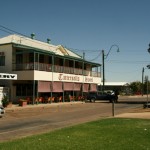
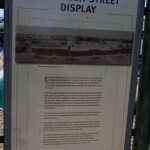


Keep enjoying your Great Aussie Adventure. Xx
xxxx
Longreach was on my Dad’s list of things to see because of the Qantas history – they went last year.. Safe travels. Xx